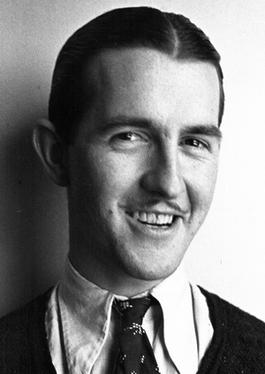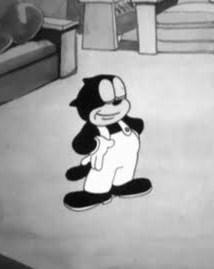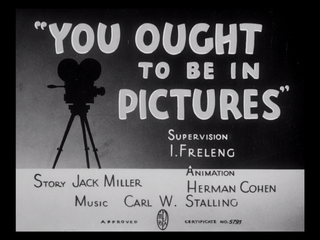Related Research Articles

Looney Tunes is an American animated franchise produced and distributed by Warner Bros. It began as a series of short films that originally ran from 1930 to 1969, concurrently with its partner series Merrie Melodies, during the golden age of American animation. Following a revival in the late 1970s, new shorts were released as recently as 2014. The two series introduced a large cast of characters, including Bugs Bunny, Daffy Duck, and Porky Pig. The term Looney Tunes has since been expanded to also refer to the characters themselves.

Isadore "Friz" Freleng, credited as I. Freleng early in his career, was an American animator, cartoonist, director, producer, and composer known for his work at Warner Bros. Cartoons on the Looney Tunes and Merrie Melodies series of cartoons from the 1930s to the early 1960s. In total he created more than 300 cartoons.

Robert Emerson Clampett Sr. was an American animator, director, producer and puppeteer best known for his work on the Looney Tunes animated series from Warner Bros. as well as the television shows Time for Beany and Beany and Cecil. He was born and raised not far from Hollywood and, early in life, showed an interest in animation and puppetry. After dropping out of high school in 1931, he joined the team at Harman-Ising Productions and began working on the studio's newest short subjects, Looney Tunes and Merrie Melodies.

Robert Porter McKimson Sr. was an American animator and illustrator, best known for his work on the Looney Tunes and Merrie Melodies series of cartoons from Warner Bros. Cartoons and later DePatie–Freleng Enterprises. He wrote and directed many animated cartoon shorts starring Bugs Bunny, Daffy Duck, Porky Pig, Foghorn Leghorn, Hippety Hopper, Speedy Gonzales, and the Tasmanian Devil, among other characters. He also developed Bugs Bunny's design in the 1943 short Tortoise Wins by a Hare.

Merrie Melodies is an American animated comedy short film series distributed by Warner Bros. Pictures. It is the companion series to Looney Tunes, and featured many of the same characters as the former series. It originally ran from August 2, 1931, to September 20, 1969, during the golden age of American animation, though it had been revived in 1979, with new shorts sporadically released until June 13, 1997. Originally, Merrie Melodies placed emphasis on one-shot color films in comparison to the black and white Looney Tunes films. After Bugs Bunny became the breakout character of Merrie Melodies and Looney Tunes transitioned to color production in the early 1940s, the two series gradually lost their distinctions and shorts were assigned to each series randomly.

Buddy is an animated cartoon character in the Looney Tunes series by Leon Schlesinger Productions. He was the second star of the series, after Bosko.
DePatie-Freleng Enterprises was an American animation studio founded by former Warner Bros. Cartoons employees in May 1963, before dissolving in 1981. Based in Burbank, California, DFE produced animation for film and television.

Piggy is the name of two animated cartoon characters in the Merrie Melodies series of films distributed by Warner Bros. The first character was a fat, black pig wearing a pair of shorts with two large buttons in the front, and his first film was You Don't Know What You're Doin'!
Arthur Davis was an American animator and director known for his time at Warner Brothers' Termite Terrace cartoon studio.

Beans the Cat is an animated cartoon character in the Warner Bros. Cartoons series of cartoons from 1935–1936. Beans was the third Warner Bros cartoon character star after Bosko and Buddy. He is voiced by Billy Bletcher and occasionally by Tommy Bond. He was created by director Friz Freleng. The character was featured in nine cartoons made in 1935 and 1936.

Tweetie Pie is a 1947 Warner Bros. Merrie Melodies cartoon directed by Friz Freleng. The short was released on May 3, 1947, and stars Tweety with Sylvester, who is called "Thomas" in this cartoon.
Warner Bros. Cartoons, Inc. was an American animation studio, serving as the in-house animation division of Warner Bros. during the Golden Age of American animation. One of the most successful animation studios in American media history, it was primarily responsible for the Looney Tunes and Merrie Melodies series of animated short films. The characters featured in these cartoons, including Bugs Bunny, Daffy Duck, and Porky Pig, are among the most famous and recognizable characters in the world. Many of the creative staff members at the studio, including directors and animators such as Chuck Jones, Friz Freleng, Robert McKimson, Tex Avery, Robert Clampett, Arthur Davis, and Frank Tashlin, are considered major figures in the art and history of traditional animation.

You Ought to Be in Pictures is a 1940 Warner Bros. Looney Tunes short film directed by Friz Freleng. The cartoon was released on May 18, 1940, and stars Porky Pig and Daffy Duck.
Tin Pan Alley Cats is a 1943 Warner Bros. Merrie Melodies directed by Bob Clampett. A follow-up to Clampett's successful Coal Black and de Sebben Dwarfs, released earlier in 1943, Tin Pan Alley Cats focuses upon contemporary themes of African-American culture, jazz music, and World War II, and features a caricature of jazz musician Fats Waller as an anthropomorphic cat. The short's centerpiece is a fantasy sequence derived from Clampett's black and white Looney Tunes short Porky in Wackyland (1938).
Cal Dalton was an American animator and director at Warner Bros. Cartoons.

The Metro-Goldwyn-Mayer cartoon studio was an American animation studio operated by Metro-Goldwyn-Mayer (MGM) during the Golden Age of American animation. Active from 1937 until 1957, the studio was responsible for producing animated shorts to accompany MGM feature films in Loew's Theaters, which included popular cartoon characters Tom, Jerry, Droopy, Butch, Spike, Tyke, and Barney Bear.
Owen Earl Duvall was an American artist and animator best known for his work on Disney comic strips in the early 1930s and for a handful of animated short films he directed at Warner Bros. Cartoons.
James Patton "Jack" King was an American animator and short film director best known for his work at Walt Disney Productions.
Beauty and the Beast is a 1934 Warner Bros. Merrie Melodies animated short film, directed by Friz Freleng. The short was released on April 14, 1934.
Robert Herman Givens was an American animator and character designer, responsible for the creation of Bugs Bunny. He was the leading character designer for Leon Schlesinger, creating over 25 successful characters for both Leon Schlesinger Productions and later Warner Bros. Cartoons. He also did the storyboards and layout designs. He worked for numerous animation studios during his career, including Walt Disney Animation Studios, Warner Bros. Cartoons, Hanna-Barbera, and DePatie–Freleng Enterprises, beginning his career during the late 1930s and continuing until the early 2000s. He was a collaborator with the Merrie Melodies/Looney Tunes directors at Warner Bros. and Chuck Jones' production company.
References
- ↑ Beck, Jerry; Friedwald, Will (1989). Looney Tunes and Merrie Melodies: A Complete Illustrated Guide to the Warner Bros. Cartoons. Henry Holt and Co. p. 29. ISBN 0-8050-0894-2.
- ↑ Lenburg, Jeff (1999). The Encyclopedia of Animated Cartoons. Checkmark Books. pp. 104–106. ISBN 0-8160-3831-7 . Retrieved 6 June 2020.
- 1 2 3 4 5 6 7 8 Barrier (2003), Warner Bros., pp. unnumbered pages